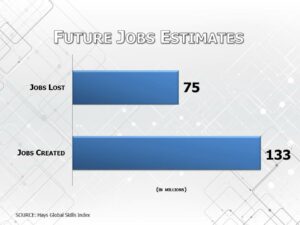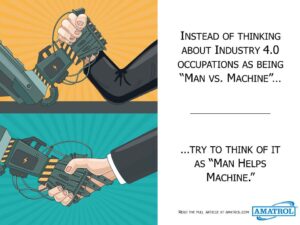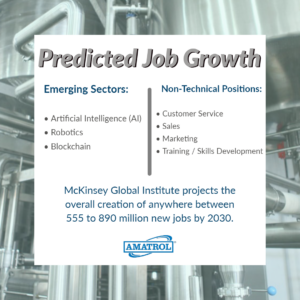To watch a Multimedia version of this story, please click here.
When we open up trusted publications and see headlines like…
“ROBOTS ARE STEALING OUR JOBS” (Entrepreneur, April 2019)
“AI EXPERT SAYS AUTOMATION COULD REPLACE 40% OF JOBS IN 15 YEARS” (Fortune, Jan. 2019)
“JOB LOSS FROM AI? THERE’S MORE TO FEAR!” (Forbes, Aug. 2018)
…it’s easy to get absolutely terrified about the future of the workforce, so much so it keeps you up at night: Will I be able to work? Can I support myself and my family?
But before a panic attack sets in, take a deep breath and realize that these sensational headlines are filled with half-truths.
“So These Headlines Are Wrong, and Jobs Aren’t Going Anywhere?”
Well, not exactly.
Currently, industry and business are experiencing a new wave of digital technology, such as artificial intelligence (AI), cloud computing, the Internet of Things (IoT), and augmented/virtual reality (AR/VR). By combining all of these features into an intelligent, interconnected ecosystem, industry leaders can add accuracy, efficiency, and productivity to their companies, all while lowering the cost of doing business.
The movement has been dubbed as the fourth Industrial Revolution – more commonly known as Industry 4.0.
However as industry continues to inch closer toward full automation, employees are worried about the eventual takeover of automated machines, and what it could mean to their future employment.
And for good reason.
According to the latest Hays Global Skills Index, a comprehensive study conducted by Hays and Oxford Economics, it found that “improvements in technology will likely lead to a ‘hollowing out’ of jobs distribution, whereby some middle-skilled jobs disappear.”
Further, a study by the McKinsey Global Institute calculated that intelligent automation technologies could save employers worldwide a staggering $15 trillion in wages by 2030.
So yes, jobs are expected to vanish. And companies will be looking to eliminate low- and middle-skilled jobs that can be completed much faster, and cheaper, by a robot. If one concluded their research there, the outlook on future jobs definitely seems bleak.
But that, my friends, is only part of the story.
“OK, Then You’re Saying There Will Be Plenty of Jobs to Choose From?”

Well, kind of.
Jobs will be aplenty, that’s for sure. Even now, the manufacturing sector is booming, and unemployment is at historic lows.
According to the Hays Global Skills Index, which looked into the roles of over 15 million workers across 20 different nations, “the rise of machines, robots and algorithms will create more jobs (133 million) than it culls (75 million).” The report goes on to conclude that automation will “transform rather than destroy” the jobs market.
However these jobs that are becoming available are not the same jobs that we have all grown accustom to. This has led to a skills gap, where a Deloitte study predicts that as many as two million jobs may not be filled over the next 10 years because the lack of qualified, properly skilled workers.
So yes, millions of jobs are expected to be available. And these potential careers are definitely intended to be filled by humans, not machines.
But prospective employees aren’t expected to walk right in, and understand these new tasks and skills. McKinsey estimates that 75 to 375 million people will have to switch occupations and/or learn new skills by 2030, “implying substantial workplace transformations and changes for all workers.”
Bottom line: employees are in need of re-training and re-skilling to become hirable in an Industry 4.0 world.
“So Because Something New Was Introduced, We Have to Be Re-Trained?! Has This Ever Happened Before?!”
Actually, introducing new technologies happens more than we think. While it may not always be on the scale of something as all-encompassing as Industry 4.0, employees are re-trained quite frequently nationwide.
For example, according to the Manhattan Institute for Policy Research, there were 47 government-sponsored worker-training programs in 2012 that cost roughly $18 billion. More recently, AT&T pledged to spend $1 billion to supply roughly 100,000 of its employees with new training in data science, cybersecurity, and other fields.
Re-training employees for new technologies is not a new phenomenon. Back in the 18th century, as horse and carriages were being phased out for a new invention called the automobile, workers were forced to not only learn about this new mode of transportation, but also how to begin mass producing them in a safe, timely manner.
Another example is the invention of the personal computer (PC). A study from McKinsey estimates that the introduction of the modern PC has enabled the creation of 15.8 million net new jobs in the United States since 1980, even after accounting for jobs displaced. Now, PCs are used in roughly 90-percent of occupations.
And it appears that Industry 4.0 occupations are heading down that same path. Currently in many industries worldwide, the most in-demand occupations or specialties did not exist 10 or even five years ago, according to the World Economic Forum, and the pace of change is set to accelerate even more.
The study concluded that it estimates 65-percent of children entering primary school today will ultimately end up working in completely new job types that don’t exist yet.
According to McKinsey, “If history is any guide, we could expect eight- to nine-percent of 2030 labor demand will be in new types of occupations that have not existed before.”
“So Then What Are Some New Types of Industry 4.0 Jobs? What Will the Employee’s Role Be?”
 Instead of thinking about Industry 4.0 occupations as being “Man vs. Machine”, try to think of it as “Man Helps Machine.”
Instead of thinking about Industry 4.0 occupations as being “Man vs. Machine”, try to think of it as “Man Helps Machine.”
Frankly, at this point, it would be impossible to eliminate human workers completely from the equation. But rather than perceive robots and automation as a threat, humans should embrace Industry 4.0, and the benefits that it can bring to their professional careers.
Sure, employee roles will be re-shaped, but having machines to do some of the “heavy lifting” will streamline processes, and free up employees’ time to accomplish higher-level tasks.
For example, take an engineer’s workload. Instead of researching, designing and building Industry 4.0-ready machines, they will also be looked upon to troubleshoot and maintain those technologies in a Smart Factory setting. Sounds like more work, right?
Not so fast. With predictive maintenance software, engineers can automatically schedule machine maintenance based on data and past repair timelines, which will lead to less machine downtime. All of that data is mined, and eventually sent to the engineers, highlighting pertinent information to keep a factory running smoothly. Factor in the power of cloud computing, and engineers can remotely wire into that machine to see the detailed data, and even perform additional updates and maintenance.
It’s not just dedicated to engineers, either. Mobile sensors can help logistics track inventory from the floor, all the way to its final destination of a store shelf, or a customer’s front door. Behavioral analytics can help spot suspicious activity in both the banking and pharmaceutical sectors.
No matter the industry, smart technologies are beginning to make work more efficient, and open up employees to focus on other areas that need immediate attention.
As for specific job titles, there is no way to pinpoint what will be needed 10 or 15 years down the road as technologies continue to advance. However the World Economic Forum predicts there will be strong employment growth in emerging sectors like AI, robotics, and blockchain.
Non-technical positions that focus on human interaction will also be sought after, including customer services, sales, marketing, and training/skills development. Overall, McKinsey projects the overall creation of anywhere between 555 to 890 million new jobs by 2030.
“This Is All So Much to Take In. How Can I Ready Myself For This?”
Don’t panic – just prepare.
McKinsey reports that 96-percent of global 500 companies’ leadership teams are not ready for the digital change. So by all means, you are not alone.
The first step to understanding employee roles in an Industry 4.0 is to communicate – open up lines of communication between senior-level staff and those workers that could be directly affected by the move to automation. Make sure both parties understand the skills it will take to manage these advanced solutions, and how one can go about learning those skills.
Remind employees that with big changes comes big opportunities for all involved. And the best way to cope with the changes is through employee training and professional development.
“It is critical that businesses take an active role in supporting their existing workforces through reskilling and upskilling, that individuals take a proactive approach to their own lifelong learning, and that governments create an enabling environment, rapidly and creatively, to assist in these efforts,” the WEF recommends.
So whether it is through job-offered professional development, or self-taught training, employees should prepare to train in new areas and develop advanced skills.

Already have some of these skills? Many people do, while others may just need to build on what they already have. Don’t have any of these skills? No worries. Community colleges across the country are gearing up, adding more classes that teach basic skills, up to the more advanced Industry 4.0 technologies, including:
- mechanical abilities, including assembly;
- working knowledge of hydraulics, pneumatics, and electronic sensors;
- electrical and mechanical print reading skills;
- programming capabilities, especially related to programmable logic controllers (PLCs), human-machine interfaces (HMIs), and other software related to smart sensors and programmable controllers;
- advanced information technology skills, such as networking and network security;
- familiarity with robots, including the basics of robot operation and programming; and
- broad-based knowledge and hands-on skills related to maintaining and troubleshooting the various components that make up the majority of automated systems.
Industry is turning to colleges to teach the right skillsets, and in turn, colleges are turning to certification organizations such as Manufacturing Skills Standards Council (MSSC) and the Smart Automation Certification Alliance (SACA) to ensure their training programs are aligned with industry needs and standards.
Fortunately, Amatrol is an industry leader in creating innovative, interactive learning solutions for industry.
 But jobs won’t rely solely on one’s technological skills. Employers will also be looking for soft skills to ensure a successful transition to Industry 4.0.
But jobs won’t rely solely on one’s technological skills. Employers will also be looking for soft skills to ensure a successful transition to Industry 4.0.
Some of those soft skills include communication, emotional empathy and responsiveness – typical human characteristics that can’t be replicated or duplicated completely by technology or machines. In order to fully exploit these Industry 4.0 opportunities, customer focus, problem-solving, and an aptitude for constant learning are essential soft skills for any level of the company.
Conclusion:
Smart Automation is coming. In fact, in many sectors, the change is already occurring. Industry 4.0 is here to stay, even with the speed bumps and detours that may come along with it.
But don’t fall for the half-truths – just because robots are being incorporated more into our everyday professional lives, doesn’t mean we are working against them for fear of losing jobs. Instead, embrace the fact that robots and automation are there to do the tedious work, all while lifting employees to focus on upskilling and take on more strategic roles within the business.
Jobs will be changing, and roles could be fluid, but the ultimate goal of producing accurate, efficient, and personalized customer service will remain the same. However employees should be open to additional learning and training, something that Amatrol’s technical training courses, equipment, and eLearning can aide in.
Ultimately, both employers and employees need to prepare for the Industry 4.0 future. But if both parties can work together, and accept the role automation is bound to play, then the transition into a Smart Factory setting should be easier than previously thought.
About Wes Scott
Wes Scott is a former public high school teacher and journalist. He is currently a Marketing Content Developer for Amatrol, Inc. Learn more about Amatrol and its technical training solutions, including eLearning, here and connect with Wes on Amatrol’s Twitter, Facebook, LinkedIn, and YouTube pages.




